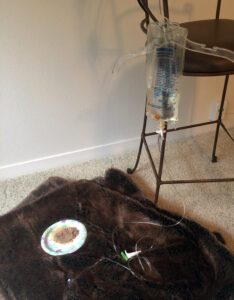Finn, a fourteen-year-old cat with chronic renal disease, began subcutaneous fluid treatment to help his body deal with toxins that his kidneys were no longer able to process normally. Subcutaneous, also called subQ for short, means just beneath the skin. SubQ fluid is received through a needle connected to a fluid line (a long, flexible tube) and fluid bag.
In the beginning, Finn’s family were reluctant to begin the treatment and Finn was also understandably stressed by this unusual activity. When it was time for him to receive his fluids, he hid in the very back corner of his mom’s closet where he believed no one would think to look for him. Once his mom found him, he loudly expressed his resentment with lots of hissing and wild wiggling. His persistent resistance complicated the process because one person needed to hold him still while the other person inserted the needle, opened the fluid line, and administered the fluid. This ten minute process felt more like ten years to Finn’s mom.
To reduce Finn’s frustration and facilitate the process for the human members of the family, Finn’s mom worked diligently to refine their routine. She created a special set-up in a quiet room with some warm, soft, blankets for him to lay on and a place to hang the fluid bag. She hangs the fluid bag up high so the fluid travels through the fluid line quickly, shortening treatment time. After she inserts the needle just beneath his skin and opens the fluid line, he receives lots of petting, ear scratches, and cat nip. He also looks forward to a reward of his favorite treats once he is finished for the day. Because Finn now has his own peaceful room for treatment and his family repeats the same steps each time, he cooperates with this predictable part of his usual routine and doesn’t need a second person to hold him still. Finn’s mom no longer has to check the closet corner for him when it is time for fluids, he now meets her in his room ready to begin.
After experimenting with different ideas, Finn’s family eventually found a perfect routine to help make subQ fluids a a normal, tolerable, part of everyone’s daily life. Not only has regular subQ fluid treatment helped Finn feel better and more hydrated, it has also greatly improved his health and lengthened his life significantly.
Subcutaneous (also called subQ) fluids can be beneficial to patients experiencing decreased kidney function due to chronic renal disease or acute renal failure. SubQ fluids are administered just beneath the skin through a needle connected to a fluid bag. While many cats initially react emotionally this unusual activity, many can tolerate predictable routines. Not every cat is guaranteed to tolerate subQ fluid treatment, but many adjust with patience. Experimenting with different comforting methods can help ease the adjustment for both the patient and the family.

